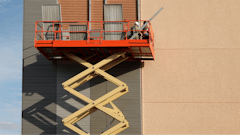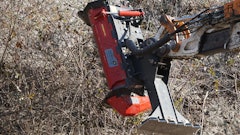
As you consider your equipment acquisition plans for the coming year, there are some variables to keep in mind. Most important is the price of new equipment.
Equipment powered by engines affected by Tier 4 emissions regulations (anything 75 horsepower and above) are expected to rise in 2013 due to the expense manufacturers have incurred while designing equipment to meet requirements which went into effect Jan. 1.
"Caterpillar has announced a 3-percent price increase to take effect in January," says Frank Manfredi of Manfredi & Associates Inc. "That's a worldwide increase. Anything with an emissions control device will increase 4 to 7 percent."
He continues, "Prices will probably jump 10 percent from two years ago to now. The expectation is when Tier 4 final starts being installed, we'll see another jump of 10 percent in January 2014. Overall, we're looking at a 20-percent price increase over a four-year period."
These price increases don't come as a surprise to many, as costs have been going up while manufacturers have been making significant investments in their engine technology. Redesigning the engine compartment to accommodate the new engines and the extra cooling capacity for them has been costly. Many companies have taken the opportunity to redesign models from the ground up and upgrade performance features as well, and now have no choice but to pass the resulting costs on to customers.
Effects on rental rates
Rental companies face the same challenges as manufacturers. The increased cost of equipment will require higher rates in order to achieve a profitable return on investment. Many are concerned whether the market can support such a rate increase.
"As new Tier 4 machines flow into fleets, it will be a challenge to keep rates up," Manfredi says. "It could take five years to work this out."
Garry Bartecki, CFO of Illini Hi-Reach Inc., a JLG dealer in Chicago, and CFO for the Associated Equipment Distributors (AED), says the increasing cost of equipment will break the rental model. "In my market, I cannot pass on equipment price increases at this time," he says. "As far as new equipment is concerned, the rental model is broken until the rates firm up because of increased construction work or the majority of rental sources have the higher-priced equipment in fleet, which could take years."
He continues, "If I buy new equipment I might find myself in a situation where I cannot hit the nut I set for myself, even if I get a decent time utilization."
Manfredi agrees that setting and getting profitable rates is a challenge, but there is an updside. "The higher-priced Tier 4 machines will drive contractors to rental rather than purchase because of the high prices, and also the uncertainty over residual values of the new machines," he says. "And of course, the economic uncertainty in not knowing if you’ll have projects in the future has been a major factor that has benefited rental companies during the past two years."
He adds, "As Tier 4i and Tier 4 final models become more common in the marketplace, there will still be a lot of Tier 3 equipment out there, especially in rental fleets, and it's less expensive. If you have a mixed fleet with Tier 3 and Tier 4 equipment, and your competition has all Tier 3, their rates will naturally be lower."
The trick will be in getting the market to understand the rate difference between Tier 3 and Tier 4 equipment, and that task falls to the rental company's sales force. It's important that sales professionals convey the reasons why Tier 4 machines command higher rates, and why those rates are justified. To ensure this message gets across effectively, Manfredi and Bartecki both note the need for rental companies to review their sales compensation plans.
"It's a tough situation which requires a lot of salesmanship to improve rates," Bartecki says. "And having proper sales compensation in place is a must if you plan to increase both volume and ROI. As we all know, we get what we pay for, and if we are looking for volume as well as higher rental rates, you have to pay and reward for both so that sales personnel have the incentive to get that extra 10 percent of the rate. If you don't ask for it, you won't get it."
Manfredi adds, "Rental companies with mixed fleets need to make their customers aware of pricing and rates. There's only so much loyalty."
Demand for Tier 4
Despite EPA regulations required of manufacturers, end-users aren't clamoring for Tier 4 equipment unless their market is in a non-attainment zone, or they're working on federal jobs that require the use of Tier 4 equipment. For many, there's trepidation over the performance of the new machines, as well as their fuel and maintenance requirements.
But in non-attainment zones, and on federal jobs, Tier 4 equipment is required. In those situations, contractors who are skittish about investing in the new equipment will rely on renting it.
"Dealers and rental houses are hearing from contractors in non-attainment zones who are demanding the new machines," says Manfredi. "And rental companies who are serving those markets will be in a good position, if they have the right equipment in their fleet."
Still a place for Tier 3
If your market is not in a non-attainment zone, continuing to invest in Tier 3 machines could make sense, and now is a good time to buy those models used. "As far as rent-to-sell goes, I hear the conversions are not taking place and customers are returning the units," Bartecki says. "Thus, there will be a lot of slightly used units out there for sale for less than the original MSRP."
With more machines in the market, prices will be softer. "It's a good time to buy used," Manfredi says. "Used equipment prices will remain at current levels for a while."
Rob Mackay, president of Ritchie Bros. Auctioneers, says here's a lot of older rental equipment flowing into the market. "Rental companies have been aging their fleets longer, but as the economy grows and they begin to loosen their belts somewhat, there will be a fair amount of used equipment out there."
Bartecki says most rental companies have aged their fleets to their limit and now have no choice but to make updates to meet increasing demand. "Backlogs at OEMs are increasing because of this," he says. "If rental companies are buying new to build rental revenues and turn old units, then used inventory will increase."
Used equipment -- a hot market?
For rental companies looking to add to their fleet and are willing to consider buying used, prices are favorable. Used equipment values were trending upward in the first two quarters of 2012, but over the summer, prices leveled off and began to drop in the early fall. Prices have since stabilized and should remain consistent for the beginning of this year, analysts say.
According to the November Rouse Rental Report, used equipment values decreased 1.4 percent for the six months ending October 31, 2012.
"We don't expect to see any dramatic adjustments up or down in the beginning of 2013," Mackay says. "Prices should remain fairly stable."
With demand for rental on the upwsing, the need to refleet undeniable for many rental businesses and the price of new equipment increasing, a case can be made for why now is a time to consider buying late-model used equipment, provided your market isn't clamoring for Tier 4 machines. Even if that demand hasn't surfaced yet, it's also a good time to consider adjusting your rate structure and sales compensation program for when these machines are a staple in your fleet.


























